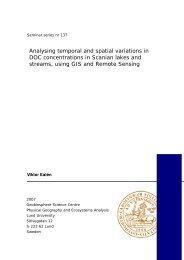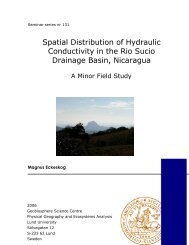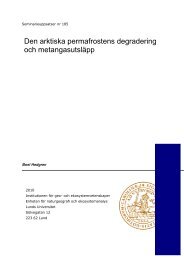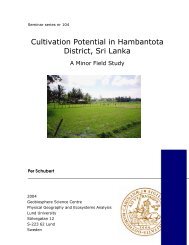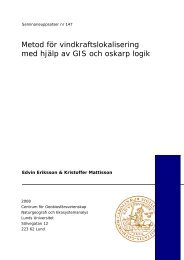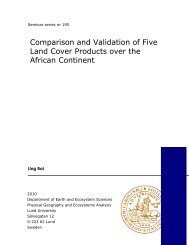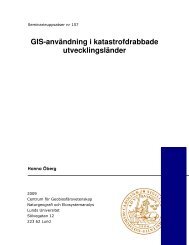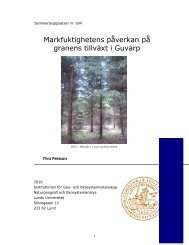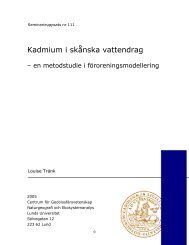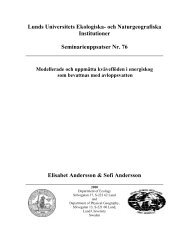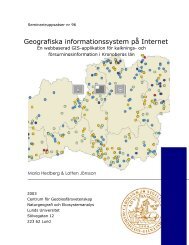Finding Potential Sites for Small-Scale Hydro Power in Uganda: a ...
Finding Potential Sites for Small-Scale Hydro Power in Uganda: a ...
Finding Potential Sites for Small-Scale Hydro Power in Uganda: a ...
You also want an ePaper? Increase the reach of your titles
YUMPU automatically turns print PDFs into web optimized ePapers that Google loves.
The closer the <strong>in</strong>terviewer is to the respondent, the better the <strong>in</strong>terviewers understand<strong>in</strong>gof the <strong>in</strong>terview material becomes. Even if there is a need <strong>for</strong> an <strong>in</strong>terpreter, the<strong>in</strong>terviewer still has a fairly direct contact with the respondent. An advantage of hav<strong>in</strong>gan <strong>in</strong>terpreter is the possibility of he or she provid<strong>in</strong>g <strong>in</strong><strong>for</strong>mation about the area, theculture and practical th<strong>in</strong>gs (Devereux & Hodd<strong>in</strong>ott 1993).4.1.1 Rural Electrification AgencyIn order to f<strong>in</strong>d out more about how <strong>Uganda</strong> fights their problems with rural electricity,we visited the Rural Electrification Agency (REA). We used a semi-structured <strong>in</strong>terviewmethod, to get a discussion about the purpose of this newly started <strong>in</strong>stitution as well as<strong>in</strong><strong>for</strong>mation of how they work. We got help from our assistant field supervisor to get an<strong>in</strong>terview. It took place at the 10 th floor of the Workers House <strong>in</strong> central Kampala. The<strong>in</strong>terviewees were a female spokesman from REA and an eng<strong>in</strong>eer, <strong>for</strong> more technicalanswers. A summary of the <strong>in</strong>terview is found <strong>in</strong> section 3.3.4 and the questions can befound <strong>in</strong> Appendix 9.1.4.1.2 Rural PopulationWhen evaluat<strong>in</strong>g our result of our GIS-analysis, we also made numerous <strong>in</strong>terviews withpeople <strong>in</strong> the countryside of our study area. Our <strong>in</strong>tention with these <strong>in</strong>terviews was to<strong>in</strong>vestigate the population’s attitude to, and need <strong>for</strong>, electricity and small-scalehydropower. As mentioned earlier, Anderson et al. (1999) claim that many energyprojects have failed because of a number of reasons (see section 3.3.2), which we basedour questions upon. In contradiction to the semi-structured qualitative <strong>in</strong>terviewmethods used be<strong>for</strong>e, the questions <strong>in</strong> a structured quantitative method are asked <strong>in</strong> apredef<strong>in</strong>ed way. All respondents are asked the same questions and no discussion ispresent. S<strong>in</strong>ce English is rarely spoken <strong>in</strong> the study area, an <strong>in</strong>terpreter was used toper<strong>for</strong>m the <strong>in</strong>terviews and to guide us <strong>in</strong> the countryside. The sample population <strong>for</strong>the <strong>in</strong>terviews was chosen along the way. The selection is not statistically valid, but weconsider it to be representative with respect to the objectives of our study. Questions areattached as Appendix 9.2.32



